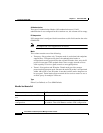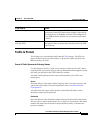
11-19
Cisco Router and Security Device Manager 2.5 User’s Guide
OL-4015-12
Chapter 11 Site-to-Site VPN
Create Site to Site VPN
Create a backup secure GRE tunnel for resilience
Check this box if you want to create a backup tunnel.
IP address of the backup GRE tunnel’s destination
Enter the IP address of the interface on the remote router at the other end of the
tunnel. (This is the source interface from the point of view of the other end of the
tunnel.)
Make sure that this address is reachable by using the ping command. The ping
command is available from the Tools menu. If the destination address specified in
the Ping dialog cannot be reached, the tunnel will not be created properly.
Tunnel IP address
Enter the IP address of the tunnel. The IP addresses of both ends of the tunnel
must be in the same subnet. The tunnel is given a separate IP address so that it can
be a private address, if necessary.
IP Address
Enter the IP address of the tunnel in dotted decimal format. For more information,
see IP Addresses and Subnet Masks.
Subnet Mask
Enter the subnet mask for the tunnel address in dotted decimal format.
Routing Information
This window enables you to configure routing for the tunneled traffic. Information
that you add in this window appears in the Routing window. Changes that you
make in the Routing window may affect routing of VPN traffic. Configuring
routing enables you to specify the networks that will participate in the
GRE-over-IPSec VPN. Additionally, if you configure a backup GRE-over-IPSec
tunnel, the keepalive packets sent by routing protocols allow the router to
determine whether the primary tunnel has failed.
Select a dynamic routing protocol if this router is being used in a large VPN
deployment with a large number of networks in the GRE over IPSec VPN. Select
static routing if a small number of networks will participate in the VPN.


















